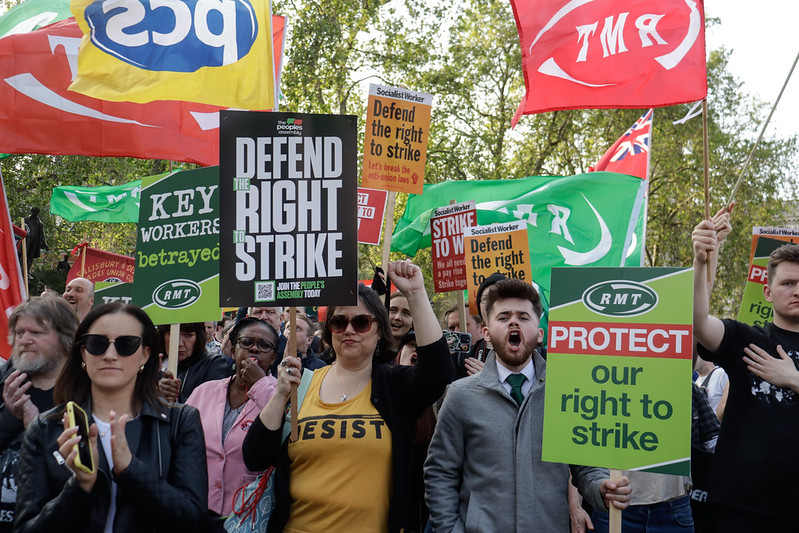Over the last few months, Labour’s New Deal for Working People has become front and centre of Labour’s otherwise confused policy offering. Labour is committed to enshrining it in law within the first 100 days of a Labour government, though parliamentary processes may well extend this in practice. While many of its headline commitments will do a lot of good for individual and organised workers, it is not clear what specific anti-trade union legislation will actually be repealed by this legislative package. The original version made a commitment to repeal all anti trade union legislation, a position that did not engage with the nuances of some of the legislation imposed since 1982. It now states that trade union legislation will be ‘updated’ and no one is quite sure what this entails other than the repeal of the recent Minimum Service Levels Act and the 2016 Trade Union Act. The key areas of anti-union legislation are:
- The ban on the closed shop
- The ban on secondary action
- The ban on secondary picketing
- The threat of fines and sequestration for breaching the law
Nearly all the legislation directly governing trade unions is located in the 1992 Trade Union and Labour Relations Consolidation Act (TULRCA). When it was first created, the main things it did was comprehensively ban the closed shop and bring together the different anti-union legislations passed between 1981 and 1992. Subsequently, any act, such as the 2016 Trade Union Act and the Minimum Service Levels Act, that seeks to place new restrictions on the industrial activities of unions does so by altering the wording of different sections of TULRCA. Given the current technocratic nature of the Labour Party, TULRCA is most likely here to stay. It is the legal foundation on which UK labour law is built, and therefore will not be repealed in full. Thus, the question is how Labour will modify it should they assume power.
What will actually be removed depends on the political will of the Labour Party, and how much Trade Union and Labour Party Liaison Organisation (TULO) can drive through. The non-affiliated Labour unions are currently being kept largely on the outside of these discussions. As Matt Wrack, FBU General Secretary, acknowledged at a fringe at Labour Party Conference in October, there is currently a lack of consensus between the TULO unions for what they think they can achieve from an agreement with Labour. This is impacting the wording of the New Deal, which is unlikely to become clear until the Clause V meeting that decides Labour’s manifesto, which is due to be drafted imminently.
The hardest legislation to change would be secondary action. It’s certainly a change that would provoke headlines about the 1970s and 80s by the right-wing press. However, in the real world, not repealing the ban on secondary action would be sub-optimal. The current dispute with Tesla in Sweden is demonstrating the importance of labour being granted the same freedom to manoeuvre as capital. Conversely, the easiest would be to restore the immunities in line with those granted by the 1906 Trades Dispute Act which were in place (with a brief three-year interregnum between 1971 and 1974) between 1906 and 1982, and effectively legislated that the courts had no place in legislating the affairs of trade unions. My logic for this is that it would be a dry legal technicality that could be smuggled through. Unions currently face the threat of being sued out of existence if they break the law, whereas employers can afford to break the law.
To provide a practical example of what amending TURLCA would look like, adding the 1906 immunities could be done by removing the current writing in Section 219 of the Act and replacing it with the wording of section 14 of the 1974 Trade Union and Labour Relations Act. Other, less dramatic changes, would be more straightforward. For instance, the number of days’ notice needed for a strike could be changed from fourteen to one, simply by substituting “1st” for “14th” in Section 234A(4)(b) of TULRCA. Equally, the maximum damages that can be awarded against a trade union could be changed simply by editing the figures in Section 22. Other alterations, such as reintroducing closed shops, and an appropriate framework around them, would require a bit more imagination.
In an era of increasing gigification, unregulated artificial intelligence, attacks on pensions, and a general race to the bottom, trade unions need to forge a new industrial status quo. To do this, they need, at the very least, an ambivalent (rather than punitive) legislative environment, which exists in a sustained period of Labour government. Just as TULRCA is the culmination of anti-union legislation of successive governments, converting it into something less punitive will take more than one legislative package from a Labour government. This long-term approach is inherently Labourist, as demonstrated by Mick Lynch’s claim at a TUC Congress fringe in September that part of trade unionism is to take the best available deal and then come back later looking for a better one. However, Labour governments’ radicalism tends to be inversely correlated with their time in office.


